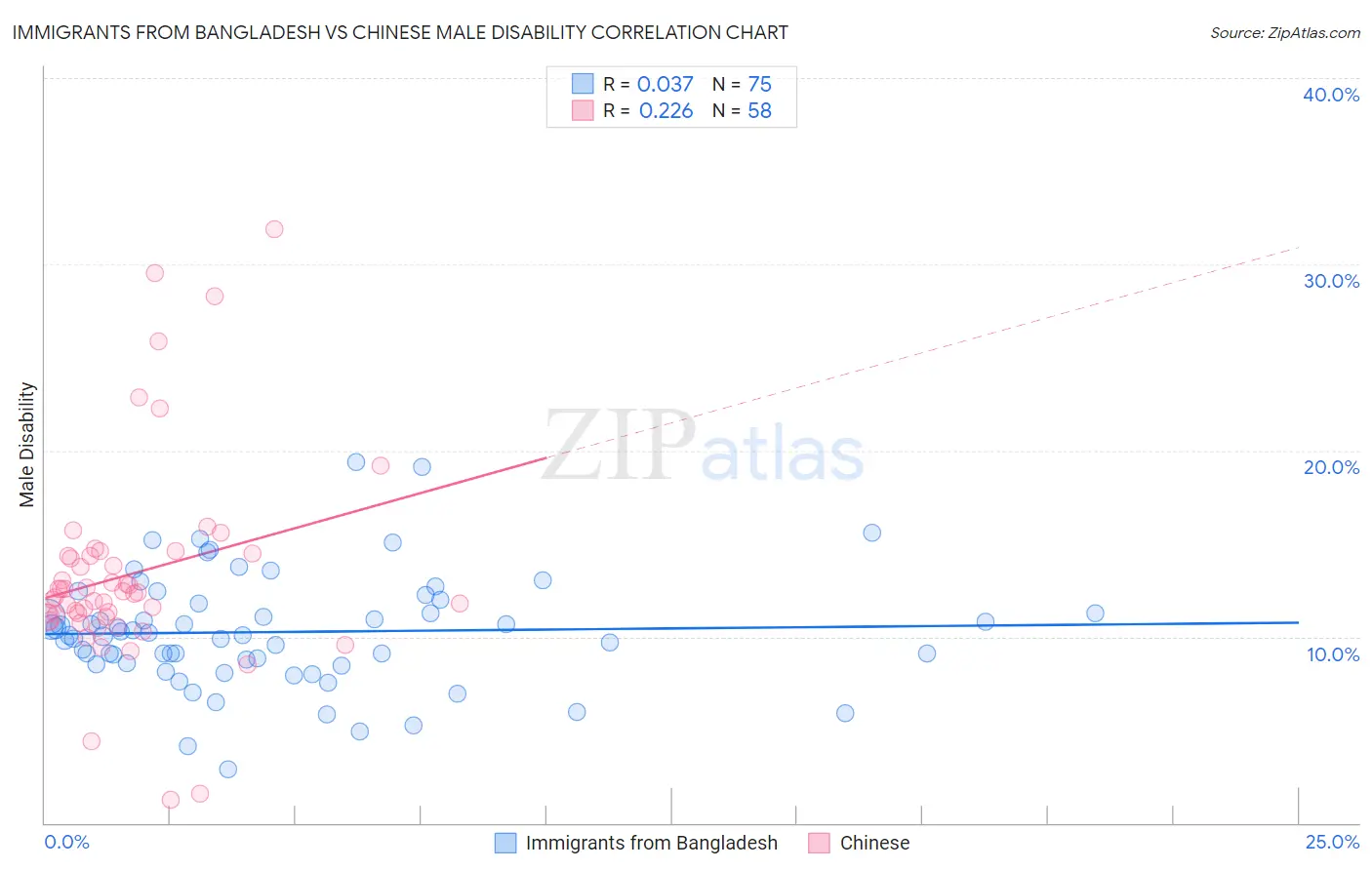Immigrants from Bangladesh vs Chinese Male Disability
COMPARE
Immigrants from Bangladesh
Chinese
Male Disability
Male Disability Comparison
Immigrants from Bangladesh
Chinese
10.3%
MALE DISABILITY
99.7/ 100
METRIC RATING
43rd/ 347
METRIC RANK
12.1%
MALE DISABILITY
0.4/ 100
METRIC RATING
255th/ 347
METRIC RANK
Immigrants from Bangladesh vs Chinese Male Disability Correlation Chart
The statistical analysis conducted on geographies consisting of 203,673,842 people shows no correlation between the proportion of Immigrants from Bangladesh and percentage of males with a disability in the United States with a correlation coefficient (R) of 0.037 and weighted average of 10.3%. Similarly, the statistical analysis conducted on geographies consisting of 64,802,721 people shows a weak positive correlation between the proportion of Chinese and percentage of males with a disability in the United States with a correlation coefficient (R) of 0.226 and weighted average of 12.1%, a difference of 17.2%.

Male Disability Correlation Summary
| Measurement | Immigrants from Bangladesh | Chinese |
| Minimum | 2.9% | 1.3% |
| Maximum | 19.4% | 31.9% |
| Range | 16.5% | 30.7% |
| Mean | 10.3% | 13.4% |
| Median | 10.1% | 12.4% |
| Interquartile 25% (IQ1) | 8.6% | 11.1% |
| Interquartile 75% (IQ3) | 11.8% | 14.4% |
| Interquartile Range (IQR) | 3.2% | 3.3% |
| Standard Deviation (Sample) | 3.0% | 5.6% |
| Standard Deviation (Population) | 3.0% | 5.5% |
Similar Demographics by Male Disability
Demographics Similar to Immigrants from Bangladesh by Male Disability
In terms of male disability, the demographic groups most similar to Immigrants from Bangladesh are Mongolian (10.3%, a difference of 0.020%), Immigrants from El Salvador (10.3%, a difference of 0.070%), Turkish (10.3%, a difference of 0.080%), Cambodian (10.3%, a difference of 0.16%), and Immigrants from Peru (10.3%, a difference of 0.19%).
| Demographics | Rating | Rank | Male Disability |
| Ethiopians | 99.8 /100 | #36 | Exceptional 10.2% |
| Immigrants | Indonesia | 99.8 /100 | #37 | Exceptional 10.2% |
| Immigrants | Kuwait | 99.8 /100 | #38 | Exceptional 10.2% |
| Afghans | 99.8 /100 | #39 | Exceptional 10.2% |
| Immigrants | Nepal | 99.8 /100 | #40 | Exceptional 10.3% |
| Taiwanese | 99.8 /100 | #41 | Exceptional 10.3% |
| Mongolians | 99.7 /100 | #42 | Exceptional 10.3% |
| Immigrants | Bangladesh | 99.7 /100 | #43 | Exceptional 10.3% |
| Immigrants | El Salvador | 99.7 /100 | #44 | Exceptional 10.3% |
| Turks | 99.7 /100 | #45 | Exceptional 10.3% |
| Cambodians | 99.7 /100 | #46 | Exceptional 10.3% |
| Immigrants | Peru | 99.7 /100 | #47 | Exceptional 10.3% |
| Israelis | 99.7 /100 | #48 | Exceptional 10.3% |
| Immigrants | Spain | 99.7 /100 | #49 | Exceptional 10.3% |
| South Americans | 99.6 /100 | #50 | Exceptional 10.3% |
Demographics Similar to Chinese by Male Disability
In terms of male disability, the demographic groups most similar to Chinese are British (12.1%, a difference of 0.010%), Slovene (12.0%, a difference of 0.20%), Guamanian/Chamorro (12.0%, a difference of 0.20%), Swiss (12.1%, a difference of 0.25%), and European (12.1%, a difference of 0.25%).
| Demographics | Rating | Rank | Male Disability |
| Poles | 0.7 /100 | #248 | Tragic 12.0% |
| Immigrants | Yemen | 0.5 /100 | #249 | Tragic 12.0% |
| Bangladeshis | 0.5 /100 | #250 | Tragic 12.0% |
| German Russians | 0.5 /100 | #251 | Tragic 12.0% |
| Slovenes | 0.5 /100 | #252 | Tragic 12.0% |
| Guamanians/Chamorros | 0.5 /100 | #253 | Tragic 12.0% |
| British | 0.4 /100 | #254 | Tragic 12.1% |
| Chinese | 0.4 /100 | #255 | Tragic 12.1% |
| Swiss | 0.3 /100 | #256 | Tragic 12.1% |
| Europeans | 0.3 /100 | #257 | Tragic 12.1% |
| Basques | 0.3 /100 | #258 | Tragic 12.1% |
| Belgians | 0.3 /100 | #259 | Tragic 12.1% |
| Swedes | 0.3 /100 | #260 | Tragic 12.1% |
| Slavs | 0.2 /100 | #261 | Tragic 12.2% |
| Norwegians | 0.2 /100 | #262 | Tragic 12.2% |